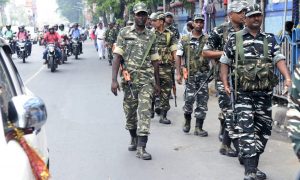Bhupender Yadav, the Minister of Environment, Forest, and Climate Change, launched the ‘Wetlands of India’ portal on October 2, 2021. The portal has been launched as part of the Iconic Week of Azadi ka Amrit Mahotsav of the Ministry of Environment, Forest, and Climate Change (MoEFCC) from October 4-10, 2021.
The portal will be a single point for accessing all sorts of information relating to the wetlands.
About the portal
The web portal, http://indianwetlands.in, provides details on the wetlands of the country. It is a dynamic system for processing information and making it available to the stakeholders in an efficient and accessible manner. Furthermore, the portal also hosts capacity-building material, data repository, videos, and related information for students.
On the portal, each State and UT has a dashboard, through which it can access information of wetlands in their administration. Soon, the portal will host additional features.
The portal aims to engage citizens. Currently, citizens can register themselves and upload wetland-related pictures across different themes. It also allows them the facility to take a pledge to become Wetland Mitra and indicate their State/UT and areas of interest. The initiative would help the respective States and UT administration in contacting the person for various programs and initiatives related to wetland conservation.
Wetland Status in India
According to the Ramsar Convention, wetlands are land areas saturated with water, either permanently or seasonally. Inland wetlands include marshes, ponds, lakes, rivers, floodplains, and swamps. The coastal wetlands include saltwater marshes, estuaries, mangroves, lagoons, and coral reefs. And, human-made wetlands include fishponds, rice paddies, and saltpans. For instance, Bhindawas Wildlife Sanctuary, the largest wetland in Haryana is a human-made freshwater wetland. Over 250 bird species use the sanctuary throughout the year as a resting and roosting site
India nearly has 4.6% of its land as wetlands that cover an area of 15.26 million hectares. Further, there are 42 sites designated as Wetlands of International Importance (Ramsar Sites), with a surface area of 1.08 million hectares.
45% of the Sunderbans National Park is a wetland ecosystem in the form of tidal rivers, creeks, and canals that inhabits many rare animal species including threatened aquatic mammals such as the Irrawaddy, Ganges- river dolphins, and the single largest population of tigers.
However, as per the Ramsar Convention on wetlands report, the wetlands are disappearing three times faster than forests, with 35% of the wetlands lost from 1970-2015. It is an alarming situation, demanding urgent attention as 40% of the world’s plant and animal species breed in wetlands. The wetlands are also vital feeding and breeding grounds for migratory birds.
In India, as a result of massive industrialization and an increase in urban population, many of the wetlands are subject to anthropogenic pressures, including land-use changes in the catchment; pollution from industry and households; encroachments; tourism; and over-exploitation of their natural resources.
All of this has substantially contributed to the depletion of India’s vital wetland ecosystems which got reflected in the foaming of Bellandur Lake in Bangalore, shrinking of the Kolleru Lake in Andhra Pradesh from 1000 to 250 sq. km, and the shrinking of Dal Lake, Srinagar by 50%.
Why are wetlands important?
Wetlands are vital not only for the ecosystems but our climate, providing essential services such as water regulation, flood control, and water purification. Wetland biodiversity is significant for ensuring good health, food supply, picturesque views facilitating tourism and thus related jobs.
Wetlands are also capable of absorbing carbon dioxide, therefore reducing global heating and pollution, and are often referred to as the “Kidneys of the Earth”.
Wetlands provide a wide range of important resources and ecosystem services such as food, water, fibre, groundwater recharge, water purification, flood moderation, erosion control, and climate regulation. They are a major source of water and the main supply of fresh water comes from an array of wetlands which help soak rainfall and recharge groundwater.
Wetlands are also important for the survival of floral and fauna. Several threatened migratory birds come to Indian wetlands. It provides wintering ground to migratory waterbirds such as the endangered Pallas’s fish-Eagle, the vulnerable Common Pochard, and the near-threatened Dalmatian Pelican, Grey-headed Fish-eagle, and Ferruginous Duck.
The Wetland Project
The Wetlands of India portal has been developed under a technical cooperation project “Wetlands Management for Biodiversity and Climate Protection” (Wetlands Project) of the Ministry of Environment, Forest and Climate Change (MoEFCC) in partnership with Deutsche Gesellschaft für Internationale Zusammenarbeit (GIZ) GmbH.
Similarly, India has been taking several wetland conservation projects to restore and protect the important wetlands in India that are the basis of living for many.
4-pronged rejuvenation of wetlands projects: The Ministry of Environment, forests, and climate undertook the restoration and rejuvenation of 130 wetlands under a four-pronged strategy, in which the nodal officers of these wetlands were trained in preparing focused management plans and in working out the health of the wetland. For the first time in the country, wetlands were graded between A to E as per their health.





















 WhatsApp us
WhatsApp us
Pingback: u31 com